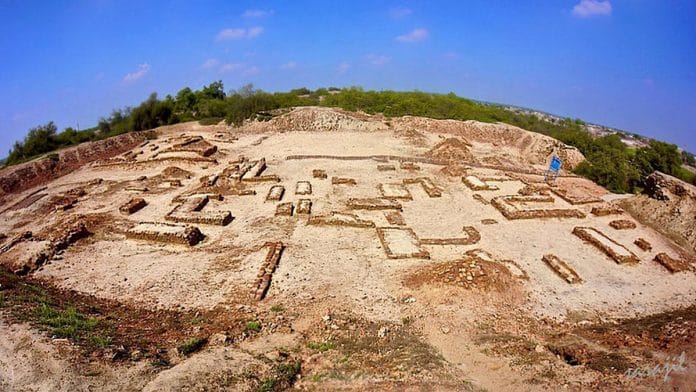Five major regional centres were located on what appears to be a grid with calculated distances separating them: Mohenjo-daro (250 ha, Sindh) on the Indus in the south; Harappa (150 ha, Punjab) on the Ravi in the north; Ganweriwala (80 ha, Cholistan) on the Ghaggar-Hakra; Rakhigarhi (+80 ha, Haryana) on the Chautang in the northeast; Dholavira (100 ha, Kutch/Gujarat) in the southwest.
Rakhigarhi and Dholavira were situated towards the outer edges of the Indus region and with Ganweriwala in the centre formed a crescent on the western boundary of the Thar. Ganweriwala was 407 kms from Rakhigarhi, 558 kms from Dholavira, 280 kms from Harappa and 308 kms from Mohenjo-daro. Harappa was 570 kms distant from Mohenjo-daro and 350 kms from Rakhigarhi.
Mohenjo-daro, the largest city, was strategically located on the Indus in central Sindh to control communications along the north-south riverine highway from the Himalayas to the sea and the east-west route from the southern Baluchistan uplands to the Ghaggar-Hakra basin.
In relation to contemporary Harappan settlements, it was a place of gigantic dimensions populated by about 100,000 people. It had two major sections. The western citadel was constructed on an enormous platform of sand and silt measuring 200 by 400 metres within a six-metre-thick mud-brick retaining wall, seven metres high. Each of the citadel’s structures had its own additional platform.
The Great Bath, a large watertight basin with a capacity to store 160 cubic metres of water, set in the centre of a complex of rooms, may have been a religious structure of state-wide importance. Bathrooms and residential buildings were also built in the citadel.
To its east, the lower city contained two- and three-storey houses built on a grid pattern of north-south streets and east-west lanes. Mohenjo-daro’s main street was ten metres wide.
House designs suggest a repetitive, modular pattern comprising individual elements such as specific rooms, staircases and courtyards. Almost every house had a bathing place connected to a drain or soak pit in the street.
The city had around 700 wells, an excellent network of drains and a number of cesspits. Some structures were possibly temples and caravanserais. Industrial areas were concentrated in the suburbs. Workshops produced artefacts of every kind manufactured by the Indus people in a manner that hints at well-developed bureaucratic controls.
Due to the high water table, it has never been possible to excavate down to the earliest levels, estimated to be at least seven metres below the present surface. Most of its excavated architecture, therefore, belongs to the latter Mature Harappan.
Also Read: Wokes are destroying beauty of language. Being blunt is better than inoffensive
Harappa is the only major city that enjoyed continuous development from the Kot Diji period into the Mature Harappan. Unlike many Early Harappan settlements, it was not rebuilt to a new plan during the Transition but grew organically. Located on the banks of the Ravi, it began c3700 BCE as a small agro-pastoral settlement with workshops for stone bead making and other crafts. Harappa’s location enabled it to control the flow of raw materials from the Himalayas.
By 2600 BCE, it had expanded into an urban centre with two walled sectors, more than twenty-five ha in area with many flourishing industries. The citadel was sited on a high mound on the west. Harappa was heavily plundered for bricks in the nineteenth century, but what remains still tell a tale of massive and impressive brick buildings, public and private, that served various purposes.
Within a perimeter wall, fourteen metres thick in places, were impressive buildings including a fifty-by-forty metre granary and a number of working platforms for craft manufacture. During the Mature Harappan, the population grew to perhaps 60,000 and the city expanded beyond the walled mounds to occupy an area of around 150 ha on four major mounds, each walled and gated. They were settled at different times as the city expanded, and may have been controlled by different elite groups.
Harappa produced a range of artefacts in great quantity, some unique to the city. A network of trading routes brought a variety of raw materials, marine resources, timber, stone and metal from distant regions for processing into various utilitarian and prestige objects for local use, as well as for regional and extra-regional trade. Harappans traded with coastal regions 900 kms to the south, and with Afghanistan, Baluchistan and the Himalayas, some 300–1000 kms to the west and north.
Harappa’s cemeteries reveal many local females were buried alongside males who were clearly not local. It suggests male immigration from different regions, mainly motivated by trade; the immigrants married local women and settled down in the city.
Harappa flourished until 1900 BCE. The excavated upper layers document the slow decay to the Late Harappan, with overcrowded housing spilling into streets and former open areas, pot-holed roads and the mixing of residential and industrial areas.
Located in the Ghaggar-Hakra valley, Ganweriwala was divided into two distinct parts, the citadel on a small mound on the west and the lower town to the east. The city is yet to be excavated. What is known comes only from surface materials from the Mature Harappan, like ceramics and clay toys and a tablet with a man seated in the yogi motif.
Rakhigarhi stands on an old bed of the Chautang (Drishadvati), a tributary of the Ghaggar-Hakra. Ongoing excavations have now extended its boundaries to nine mounds covering an area of about 350 ha. Rakhigarhi appears to have been first settled during the Early Harappan.
It expanded greatly during the Mature Harappan with flourishing industries, walled residential areas and cardinally oriented streets. Located on a mound in the northwest was the walled citadel with a platform with fire altars, a well and pits containing cattle bones.
Dholavira, built on Khadir Island in the Rann of Kutch, was located on the tri-junction of water routes from Sindh, Rajasthan and Kutch at a time when sea levels were two to six metres higher than at present. It was ideally placed to control navigation between the south and the rest of the Harappan region. Constructed in stone, it was enclosed by successive massive walls eighteen metres wide and six metres high.
 This excerpt from Alan Machado (Prabhu)’s ‘Discovering India Anew: Out of Africa to its Early History’ has been published with permission from Orient BlackSwan.
This excerpt from Alan Machado (Prabhu)’s ‘Discovering India Anew: Out of Africa to its Early History’ has been published with permission from Orient BlackSwan.






